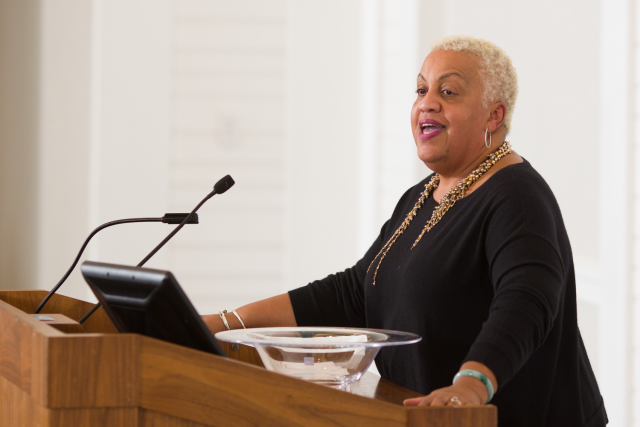Before Tuck, I was a people manager at one of the world’s largest global consulting firms. I became aware of the wide range of inequities and organizational issues plaguing companies in a diverse array of industries—issues that were symptomatic of those permeating other organizations.
As I grew within the company, I realized the urgency and importance that we as men have in elevating the discourse on gender equity and equality.
In recent decades, public- and private-sector organizations have started introducing programs to increase the number of women in leadership roles and to boost diversity and inclusion (D&I) initiatives at all levels. However, organizations have failed to pay attention to long-term retention through effective mentorship, leadership development, and cultural change.
What does the data say?
From media coverage about the gender pay gap to the #MeToo movement—and from a growing body of empirical evidence showing that the advancement of D&I efforts within organizations is integral to improving gender equity, diversity, and financial performance—there has never been greater awareness of the need for and benefits of promoting women.
However, the numbers paint a drastically different story.
In 2018, only about 5 percent of Fortune 500 and S&P 500 CEOs were women; multicultural women were almost nonexistent at the top. Data from the Working Mother Research Institute in 2018 found that while 48 percent of men said they received detailed information on career paths to profit-and-loss (P&L) jobs in the previous 24 months, just 15 percent of women reported the same. Similarly, while 54 percent of men reported that they’ve had a career discussion with a mentor or sponsor in the previous 24 months, only 39 percent of women had. These numbers illustrate the stark contrast in the mentorship of men and women.
IBM surveyed 2,300 global organizations, and on average, just 18 percent of top leadership positions—including the C-suite, VPs, directors, and senior managers—are held by women.
In 2019, IBM published “Women, Leadership, and the Priority Paradox,” highlighting the fact that this is a “top of the house” problem, with many organizations giving lip service to advancing women but addressing the issue haphazardly and ineffectively. Organizations seem to be over-relying on “good intentions and applying a laissez-faire approach to diversity,” rather than applying the same discipline and focus on its operational execution that they apply to other aspects of financial and organizational performance. IBM surveyed 2,300 global organizations, and on average, just 18 percent of top leadership positions—including the C-suite, VPs, directors, and senior managers—are held by women.
These results are staggering. They are evidence of the status quo and require us to take a deeper look at how we can leverage existing organizational competencies and capabilities, such as leading change through effective mentoring, advocacy or sponsorship, to increase the ranks of women at all levels.
What can men do to help?
Men can play a pivotal role in reconstructing societal expectations about gender roles in leadership and management positions. As the data illustrate, men are typically the majority power holders within organizations; they are already in positions of leadership and can therefore change the status quo. Hence, it’s imperative that men are engaged and included in the conversation as part of the solution.
Brad Johnson, professor of psychology at the United States Naval Academy, and David Smith, associate professor of sociology at the US Naval War College, are co-authors of Athena Rising: How and Why Men Should Mentor Women. As president of Tuck’s Men as Allies initiative, I invited Johnson and Smith to Tuck to conduct a two-day workshop with male allies and the larger Tuck community on the importance of male allyship and mentorship in the workplace.
Johnson and Smith asserted that in male-dominated industries and professions, such as STEM, finance, and the military, there aren’t enough women, particularly in senior positions, to mentor other women rising within the organization—which shifts the responsibility for such mentoring to men.
Men need to be aware of the influence they typically wield in their organization. When women in male-dominated professions are mentored by men, they receive more money, more promotions, and have clearer tangible career outcomes. This is not because men are inherently better mentors but because of power dynamics. Johnson and Smith reported research showing that when a man publicly promotes or sponsors a woman, his end-of-year evaluations go up. When a woman is a public sponsor for another woman, her ratings go down. The man is considered a champion of diversity, whereas the woman is viewed as showing favoritism. This dichotomy represents a different sort of inequity affecting organizations but should create an even greater sense of urgency among men to contribute more in this area.
How can men be good mentors?
At Tuck, as part of Men as Allies, we organized an “Ask Me Anything” event on campus. Men and women were separated into groups and provided with a list of prompts to encourage candid conversations about difficult topics—in school, in the workplace, even in social settings. One of the primary themes that emerged from these conversations was that in the post-MeToo age, men are grappling with very real concerns about forging authentic and close relationships with women. For example, they are more hesitant about meeting women at night for fear that they’ll be the topic of office gossip or a report to HR.
Johnson and Smith posit that if men have anxiety about associations with women in the workplace, there’s only one way to fix it: more exposure. Men must lean in—have more coffee chats, more interactions, and more public conversations with women to gain a better understanding of and greater empathy with them.
As part of their research, Johnson and Smith interviewed successful, powerful women across industries and professions who had been mentored by men. The number-one mentoring skill that all of them mentioned was that their male mentors were great listeners. The authors delved deeper and found that these mentors had a sense of humility and an intention to learn; they don’t have all the answers and they don’t make assumptions. In essence, these mentors exercised high emotional intelligence and listened with a purpose.
Similarly, in male-centric environments, women often receive the message that they don’t fit—that they’re a unicorn. Men need to counteract this imposter-syndrome messaging through encouragement and by ensuring that women feel a sense of belonging and of pride in their work. And this support should continue in public environments. Men have the responsibility to push back against locker-room culture and be comfortable talking with and about women at all times.
In addition, men need to actively promote networking with their female colleagues. The mentoring relationship should progress to a sponsorship model in which men continuously advocate for and actively promote their female colleagues across all organizational levels.
At their very core, gender inequities and D&I issues are leadership issues… The time has come for men in leadership positions to realize that their responsibility and accountability as a leader hinges on actionable inclusivity and on closing the power balance gap.
Finally, men need to recognize that when it comes to excellent leadership, they have much to learn from the women around them. The traditional model of mentorship has been hierarchical and one-way: framing men as champions or heroes has led to further entrenchment of our gendered status quo. The last thing that women need is men “rescuing” them or assuming the role of the workplace knight in shining armor.
How will this benefit organizations?
The tangible and intangible benefits of a senior male executive becoming an active mentor of and sponsor for a female colleague and advancing D&I initiatives are well documented. Cross-gender reciprocal mentorship relationships are symbiotic—women benefit through greater access to resources, information, coaching, and advancement opportunities, and men through broader networks and by becoming more attuned, emotionally intelligent, and empathetic leaders. A win-win for everyone.
At their very core, gender inequities and D&I issues are leadership issues. Gender equity is everyone’s business. The time has come for men in leadership positions to realize that their responsibility and accountability as a leader hinges on actionable inclusivity and closing the power balance gap. Leaders in all organizations, public and private, need to introduce a call to action and build a culture that promotes and advances cross-gender mentorship relationships across all levels. This is no longer a “nice to have” for organizations—it is a necessity to be embedded in every organization’s ethos, mission, values, and culture.

Arsalan Suhail is a recent MBA graduate of the Class of 2020 from the Tuck School of Business at Dartmouth, where he was a recipient of the Julia Stell Award, the president of the Men as Allies organization, and served on Forte Foundation’s Male Allyship MBA Executive Steering Committee. Before Tuck, Arsalan was a leader in IBM’s strategy consulting practice and was recognized in Consulting Magazine’s 2017 list of “35 under 35” for Excellence in Leadership. He’s currently the director of operations and business development at TrueLearn and part of LLR Partners’ Growth Accelerator Program.

